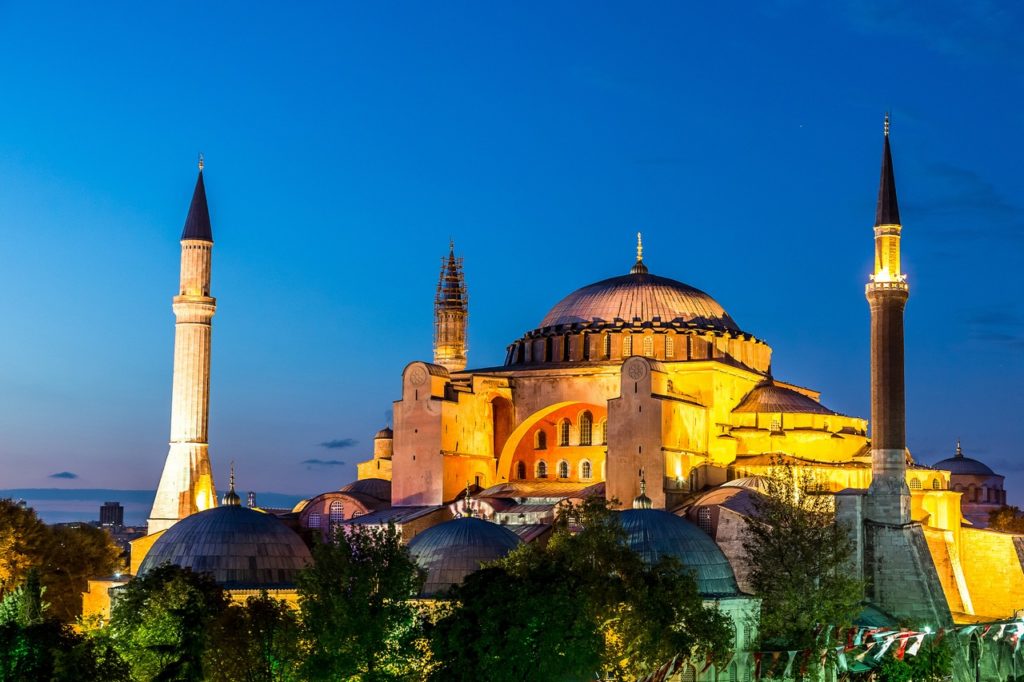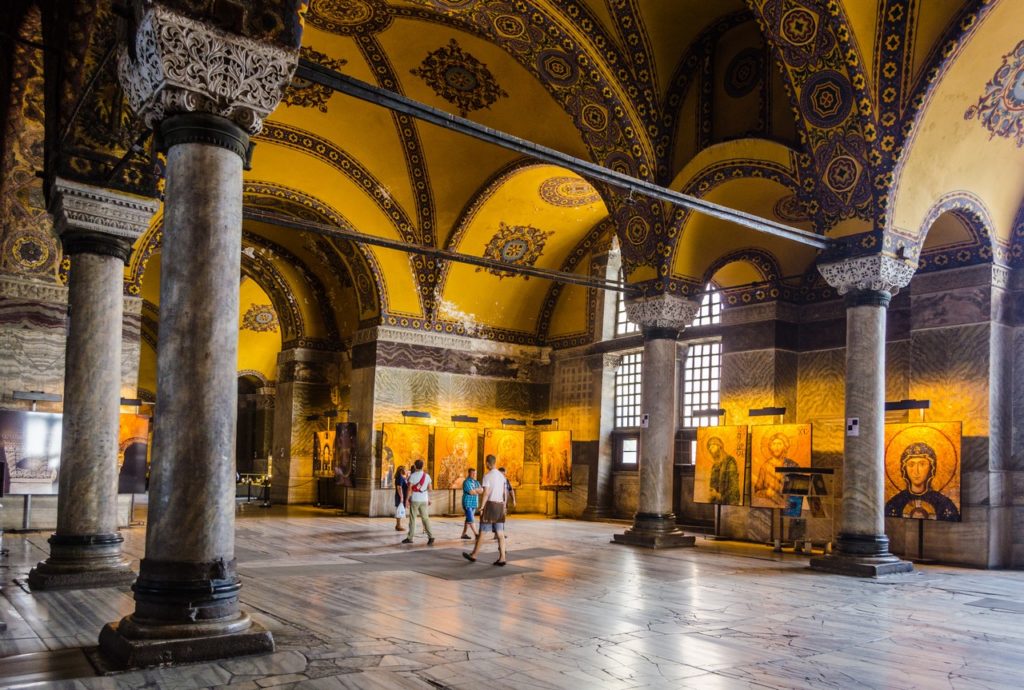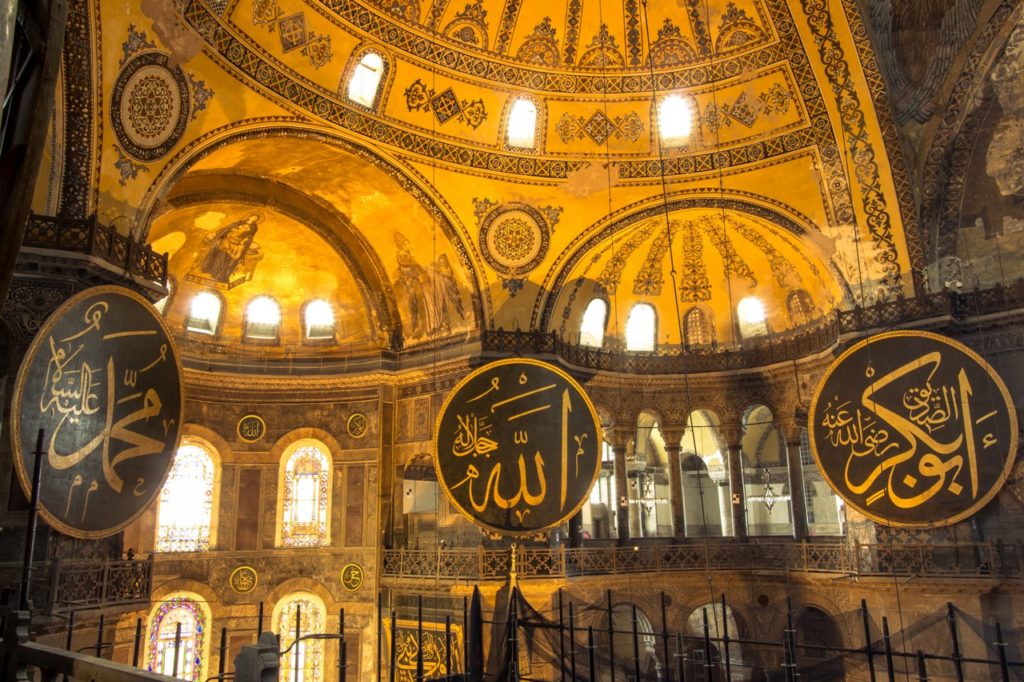
Hagia Sophia means “Sacred Wisdom” in English. Emperor Justianian dedicated it to Jesus Christ and made his famous statement: “ Solomon, I have surpassed you. Because King Solomon of Israel, son of King David, built a huge temple of God in Jerusalem (1 Kings chapter 8).
Hagia Sofia was built three times. The first was a basilica with a wooden roof and was built in 390 AD. This original church Megale Ecclesia (Great Church) burned down in an uproar in 404. Theodosius replaced it with a huge basilica which was burnt down during the Nika revolt against Justinian in 532. Justinian began to rebuild Hagia Sophia the same year . The architects were two geniuses from Anatolia, Antemio de Tralles, an engineer and mathematician, and Isidore de Mileto, an architect. They used materials from all over the empire. Ten thousand workers worked in construction under the supervision of a hundred master builders.
Hagia Sophia has a classical basilica plan and the main building plan is a rectangle 70m / 230ft wide and 75m / 246ft long. The central space of Hagia Sophia is divided on both sides of the side corridors by four large pillars and 107 columns (40 below, 67 above) between them. The space is covered by a huge dome 55.60 m high. The dome, due to earthquakes and restorations, is slightly elliptical with a diameter of 31.20 m / 102 ft on one axis and 32.80 m / 107.60 ft on the other.
When the Turks captured Constantinople in 1453, Sultan Mehmet immediately went to Hagia Sophia and ordered its conversion into a mosque. Islamic elements such as minarets, mihrab and minber were added, all positioned appropriately to face Mecca, 10 degrees south of the main axis of the building. The architect Sinan carried out restorations and added Islamic elements to the building. Buttresses were added during the Ottoman era. Two huge marble jugs were brought from Pergamon in the s. XVI and were probably used to store candle oil. The eight round wooden plaques at the gallery level are fine examples of Islamic calligraphy. The names painted on these plates are Allah, the Prophet Muhammad, the first four caliphs Ebubekir, Omer, Osman and Ali, and the two grandsons of Muhammad, Hasan and Huseyin.

Ayasofya has been used as a church for 916 years and as a mosque for 481 years. In 1934, by order of Mustafa Kemal Ataturk, it was converted into a museum and has been open to visitors ever since.
There are many mosaics on the walls of this church. Whitewashing or plasters from the iconoclastic or Islamic period helped protect the mosaics. The most important mosaics are:
In the inner narthex above the main entrance, also called the imperial gate, there is a mosaic of the s. X representing Jesus as a pantocrator seated on a throne of jewels, dressed as an empire and making a gesture of blessing with his right hand. In his left hand, he holds a book with an inscription of these words: “Peace with you, I am the light of the world”. On both sides of Jesus Christ there are two medallions. The Virgin Mary on the left and an angel with a staff on the right. Emperor Leo VI appears on his knees before Jesus.

Winged angels with covered faces are depicted on the pendants. Those of the Western pendants are painted imitations of the Fossati restoration.
On the main apse is the mosaic which represents the Virgin Mary with the Baby Jesus. She is sitting on a bench, her feet resting on a stool. Your right hand is on your son’s shoulder and his left is on his knee. Jesus raises his right hand to bless and holds a scroll in his left hand.
The galleries; In the first place, the most important scene is the mosaic of the Deesis of the s. XIII in which Jesus stands between Mother Mary and John the Baptist, and they demand from Jesus mercy for humanity.
At the end of the last section of the south gallery is a mosaic showing Jesus Christ on his throne with his right hand blessing humanity and holding the Bible in his left hand. On the left, the Byzantine emperor of the s. XI Constantine IX Monomaque offers a bag of money and the Empress Zoe holds a parchment on the right. The Emperor’s face in the mosaic changed every time Zoe changed husbands. Constantine IX was Zoe’s third husband.
To the right of the Zoe mosaic is a 12C mosaic. XII which shows the Virgin Mary with the infant Jesus flanked by Emperor John II Komnenos offering a bag of gold and Empress Eirene, with red hair, holding a scroll. Continuing from the mosaic on the side wall is the figure of Prince Alexius.
At the end of the interior narthex, before going out into the patio (out today) is the beautiful mosaic of s. X: The Virgin Mary with the infant Jesus on her knees, on one side the Emperor Constantine offers a small model of the city as it is. accepted as founder, on the other hand, the emperor Justinian proposed the model of Hagia Sophia as the emperor who had it built.

